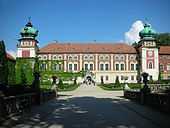Łańcut Castle
| Łańcut Castle | |
|---|---|
 | |
| General information | |
| Architectural style | Baroque |
| Town or city | Łańcut |
| Country | Poland |
| Construction started | 1629 |
| Completed | 1642 |
| Client | Stanisław Lubomirski |
| Design and construction | |
| Architect |
Maciej Trapola, Krzysztof Mieroszewski, Tylman Gamerski |
Łańcut Castle is a 17th-century palace in Łańcut, Poland. It now houses a large museum. The castle is situated in the centre of the town and constructed in the style of a grand aristocratic palace-residence.
The castle is one of the Polish National Historic Monuments (Pomnik historii), as designated September 1, 2005, and tracked by the National Heritage Board of Poland.
History
The site was originally occupied by castle built by Stanisław Lubomirski in 1629–42.[1] The owner secured the services of architect Matteo Trapola and the stuccoist Giovanni Battista Falconi, in order to build a fortified residence.[1]
In the second half of the 18th century, Izabela Lubomirska, née Czartoryski, converted the castle into the present palace complex.[1] She extended it and had the interiors remodelled. Another reconstruction occurred in 1894–1903 in the style of French Neo-baroque.[1]
During its history, it has been the home of the noble Polish Pilecki, Stadnicki, Lubomirski, and Potocki families. The palace is currently a museum particularly well known for its large collection of historic carriages.[1] In the castle grounds there is a park with the little romantic castle, a coachhouse with a collection of carriages and a guest-house in the English style.
References
External links
|
Coordinates: 50°04′07″N 22°14′05″E / 50.0685°N 22.2346°E